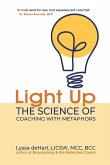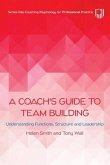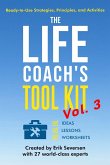Joan SwartSkills, Tools and Techniques for Effective Coaching
Coach's Casebook
Skills, Tools and Techniques for Effective Coaching
Herausgeber: Guirguis, Christine
Joan SwartSkills, Tools and Techniques for Effective Coaching
Coach's Casebook
Skills, Tools and Techniques for Effective Coaching
Herausgeber: Guirguis, Christine
- Gebundenes Buch
- Merkliste
- Auf die Merkliste
- Bewerten Bewerten
- Teilen
- Produkt teilen
- Produkterinnerung
- Produkterinnerung
Master the theory and skills needed to support employees and coach them to reach their full potential.
Andere Kunden interessierten sich auch für
![Light Up Light Up]() Lyssa DehartLight Up29,99 €
Lyssa DehartLight Up29,99 €![A Coach's Guide to Team Building: Understanding Functions, Structure and Leadership A Coach's Guide to Team Building: Understanding Functions, Structure and Leadership]() Helen SmithA Coach's Guide to Team Building: Understanding Functions, Structure and Leadership36,99 €
Helen SmithA Coach's Guide to Team Building: Understanding Functions, Structure and Leadership36,99 €![A Coach's Dream Business Journal A Coach's Dream Business Journal]() Joelene MillsA Coach's Dream Business Journal25,99 €
Joelene MillsA Coach's Dream Business Journal25,99 €![The Life Coach's Tool Kit, Vol. 3 The Life Coach's Tool Kit, Vol. 3]() Erik SeversenThe Life Coach's Tool Kit, Vol. 317,99 €
Erik SeversenThe Life Coach's Tool Kit, Vol. 317,99 €![Roi in Action Casebook Roi in Action Casebook]() Patricia Pulliam PhillipsRoi in Action Casebook61,99 €
Patricia Pulliam PhillipsRoi in Action Casebook61,99 €![Management Consulting Today and Tomorrow Casebook Management Consulting Today and Tomorrow Casebook]() Management Consulting Today and Tomorrow Casebook139,99 €
Management Consulting Today and Tomorrow Casebook139,99 €![Casebook of Chinese Business Management Casebook of Chinese Business Management]() Casebook of Chinese Business Management60,99 €
Casebook of Chinese Business Management60,99 €-
-
-
Master the theory and skills needed to support employees and coach them to reach their full potential.
Produktdetails
- Produktdetails
- Verlag: Kogan Page
- Seitenzahl: 432
- Erscheinungstermin: 25. Juli 2023
- Englisch
- Abmessung: 250mm x 175mm x 32mm
- Gewicht: 1279g
- ISBN-13: 9781398610491
- ISBN-10: 1398610496
- Artikelnr.: 65158503
- Herstellerkennzeichnung
- Libri GmbH
- Europaallee 1
- 36244 Bad Hersfeld
- gpsr@libri.de
- Verlag: Kogan Page
- Seitenzahl: 432
- Erscheinungstermin: 25. Juli 2023
- Englisch
- Abmessung: 250mm x 175mm x 32mm
- Gewicht: 1279g
- ISBN-13: 9781398610491
- ISBN-10: 1398610496
- Artikelnr.: 65158503
- Herstellerkennzeichnung
- Libri GmbH
- Europaallee 1
- 36244 Bad Hersfeld
- gpsr@libri.de
Joan Swart, Christine Guirguis
Chapter
01: Introduction and misconceptions of coaching; Section
ONE: Models and frameworks; Chapter
02: The three Cs of coaching and professional practice; Chapter
03: Awareness and accountability in coaching; Chapter
04: Building habits; Section
TWO: Competencies; Chapter
05: Coach supervision
who needs it?; Chapter
06: Coaching presence; Chapter
07: The importance of self
management for a coach; Chapter
08: Are you listening to listening ? The art of listening; Chapter
09: The power of non
directive questioning; Chapter
10: Clarity from heart
brain connection to self
discovery; Chapter
11: Seeking transformation versus focusing on solutions; Section
THREE: Approaches; Chapter
12: Holistic transformation; Chapter
13: Neuroscience
based coaching; Chapter
14: Masculine/feminine energy aspects in coaching; Chapter
15: Mindfulness and psychological flexibility in emotion
based coaching; Section
FOUR: Techniques and tools; Chapter
16: Embodiment; Chapter
17: Identifying and challenging blind spots in coaching; Chapter
18: Coaching tools and techniques; Chapter
19: The eyes watch but the brain sees
Visualization as a coaching tool for shifting the client's present view; Chapter
20: The Wheel of Life; Section
FIVE: Transforming theory into practice
Application and implementation; Chapter
21: Transitioning from theory to practice; Chapter
22: Imposter syndrome; Chapter
23: Ikigai; Chapter
24: Preventing burnout by attaining a healthy work and personal life balance; Chapter
25: Combining coaching and mindfulness; Chapter
26: Establishing an effective coaching dialogue; Chapter
27: Expanding modes of mind
From doing to being and becoming; Chapter
28: The power of intention
Life coaching and the gap between intention and action; Chapter
29: Overcoming fear: Stepping out of your comfort zone; Section
SIX: Transforming theory into practice
Execution; Chapter
30: Goal setting
be SMARTER!; Chapter
31: Sustaining and committing to action; Chapter
32: The discovery call; Chapter
33: Coaching ethics
don't be a plastic coach!; Chapter
34: Structuring the session (or not); Chapter
35: Questioning techniques; Section
SEVEN: Special niches and target groups; Chapter
36: Leadership and executive coaching; Chapter
37: Coaching and mental health; Chapter
38: Coaching 'difficult' personality types; Chapter
39: Empowering women to overcome cultural barriers; Chapter
40: Conclusion;
01: Introduction and misconceptions of coaching; Section
ONE: Models and frameworks; Chapter
02: The three Cs of coaching and professional practice; Chapter
03: Awareness and accountability in coaching; Chapter
04: Building habits; Section
TWO: Competencies; Chapter
05: Coach supervision
who needs it?; Chapter
06: Coaching presence; Chapter
07: The importance of self
management for a coach; Chapter
08: Are you listening to listening ? The art of listening; Chapter
09: The power of non
directive questioning; Chapter
10: Clarity from heart
brain connection to self
discovery; Chapter
11: Seeking transformation versus focusing on solutions; Section
THREE: Approaches; Chapter
12: Holistic transformation; Chapter
13: Neuroscience
based coaching; Chapter
14: Masculine/feminine energy aspects in coaching; Chapter
15: Mindfulness and psychological flexibility in emotion
based coaching; Section
FOUR: Techniques and tools; Chapter
16: Embodiment; Chapter
17: Identifying and challenging blind spots in coaching; Chapter
18: Coaching tools and techniques; Chapter
19: The eyes watch but the brain sees
Visualization as a coaching tool for shifting the client's present view; Chapter
20: The Wheel of Life; Section
FIVE: Transforming theory into practice
Application and implementation; Chapter
21: Transitioning from theory to practice; Chapter
22: Imposter syndrome; Chapter
23: Ikigai; Chapter
24: Preventing burnout by attaining a healthy work and personal life balance; Chapter
25: Combining coaching and mindfulness; Chapter
26: Establishing an effective coaching dialogue; Chapter
27: Expanding modes of mind
From doing to being and becoming; Chapter
28: The power of intention
Life coaching and the gap between intention and action; Chapter
29: Overcoming fear: Stepping out of your comfort zone; Section
SIX: Transforming theory into practice
Execution; Chapter
30: Goal setting
be SMARTER!; Chapter
31: Sustaining and committing to action; Chapter
32: The discovery call; Chapter
33: Coaching ethics
don't be a plastic coach!; Chapter
34: Structuring the session (or not); Chapter
35: Questioning techniques; Section
SEVEN: Special niches and target groups; Chapter
36: Leadership and executive coaching; Chapter
37: Coaching and mental health; Chapter
38: Coaching 'difficult' personality types; Chapter
39: Empowering women to overcome cultural barriers; Chapter
40: Conclusion;
Chapter
01: Introduction and misconceptions of coaching; Section
ONE: Models and frameworks; Chapter
02: The three Cs of coaching and professional practice; Chapter
03: Awareness and accountability in coaching; Chapter
04: Building habits; Section
TWO: Competencies; Chapter
05: Coach supervision
who needs it?; Chapter
06: Coaching presence; Chapter
07: The importance of self
management for a coach; Chapter
08: Are you listening to listening ? The art of listening; Chapter
09: The power of non
directive questioning; Chapter
10: Clarity from heart
brain connection to self
discovery; Chapter
11: Seeking transformation versus focusing on solutions; Section
THREE: Approaches; Chapter
12: Holistic transformation; Chapter
13: Neuroscience
based coaching; Chapter
14: Masculine/feminine energy aspects in coaching; Chapter
15: Mindfulness and psychological flexibility in emotion
based coaching; Section
FOUR: Techniques and tools; Chapter
16: Embodiment; Chapter
17: Identifying and challenging blind spots in coaching; Chapter
18: Coaching tools and techniques; Chapter
19: The eyes watch but the brain sees
Visualization as a coaching tool for shifting the client's present view; Chapter
20: The Wheel of Life; Section
FIVE: Transforming theory into practice
Application and implementation; Chapter
21: Transitioning from theory to practice; Chapter
22: Imposter syndrome; Chapter
23: Ikigai; Chapter
24: Preventing burnout by attaining a healthy work and personal life balance; Chapter
25: Combining coaching and mindfulness; Chapter
26: Establishing an effective coaching dialogue; Chapter
27: Expanding modes of mind
From doing to being and becoming; Chapter
28: The power of intention
Life coaching and the gap between intention and action; Chapter
29: Overcoming fear: Stepping out of your comfort zone; Section
SIX: Transforming theory into practice
Execution; Chapter
30: Goal setting
be SMARTER!; Chapter
31: Sustaining and committing to action; Chapter
32: The discovery call; Chapter
33: Coaching ethics
don't be a plastic coach!; Chapter
34: Structuring the session (or not); Chapter
35: Questioning techniques; Section
SEVEN: Special niches and target groups; Chapter
36: Leadership and executive coaching; Chapter
37: Coaching and mental health; Chapter
38: Coaching 'difficult' personality types; Chapter
39: Empowering women to overcome cultural barriers; Chapter
40: Conclusion;
01: Introduction and misconceptions of coaching; Section
ONE: Models and frameworks; Chapter
02: The three Cs of coaching and professional practice; Chapter
03: Awareness and accountability in coaching; Chapter
04: Building habits; Section
TWO: Competencies; Chapter
05: Coach supervision
who needs it?; Chapter
06: Coaching presence; Chapter
07: The importance of self
management for a coach; Chapter
08: Are you listening to listening ? The art of listening; Chapter
09: The power of non
directive questioning; Chapter
10: Clarity from heart
brain connection to self
discovery; Chapter
11: Seeking transformation versus focusing on solutions; Section
THREE: Approaches; Chapter
12: Holistic transformation; Chapter
13: Neuroscience
based coaching; Chapter
14: Masculine/feminine energy aspects in coaching; Chapter
15: Mindfulness and psychological flexibility in emotion
based coaching; Section
FOUR: Techniques and tools; Chapter
16: Embodiment; Chapter
17: Identifying and challenging blind spots in coaching; Chapter
18: Coaching tools and techniques; Chapter
19: The eyes watch but the brain sees
Visualization as a coaching tool for shifting the client's present view; Chapter
20: The Wheel of Life; Section
FIVE: Transforming theory into practice
Application and implementation; Chapter
21: Transitioning from theory to practice; Chapter
22: Imposter syndrome; Chapter
23: Ikigai; Chapter
24: Preventing burnout by attaining a healthy work and personal life balance; Chapter
25: Combining coaching and mindfulness; Chapter
26: Establishing an effective coaching dialogue; Chapter
27: Expanding modes of mind
From doing to being and becoming; Chapter
28: The power of intention
Life coaching and the gap between intention and action; Chapter
29: Overcoming fear: Stepping out of your comfort zone; Section
SIX: Transforming theory into practice
Execution; Chapter
30: Goal setting
be SMARTER!; Chapter
31: Sustaining and committing to action; Chapter
32: The discovery call; Chapter
33: Coaching ethics
don't be a plastic coach!; Chapter
34: Structuring the session (or not); Chapter
35: Questioning techniques; Section
SEVEN: Special niches and target groups; Chapter
36: Leadership and executive coaching; Chapter
37: Coaching and mental health; Chapter
38: Coaching 'difficult' personality types; Chapter
39: Empowering women to overcome cultural barriers; Chapter
40: Conclusion;









